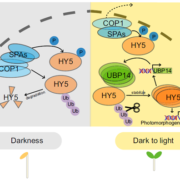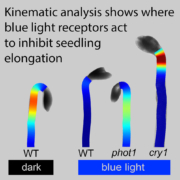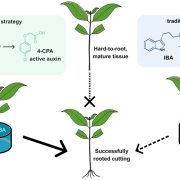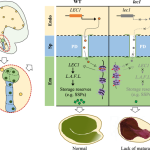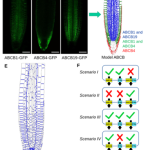KAI2 regulates seedling development by mediating light-induced remodeling of auxin transport (New Phytol)
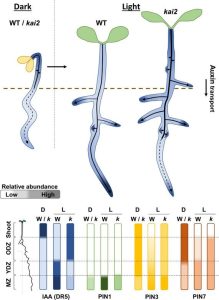 Seed germination is can be described as having two phases depending on light availability, skoto- and photomorphogenesis. Skotomorphogenesis, which occurs while the seed is still buried, is characterized by the elongation of the coleoptile and the inhibition of the root system. When the seed reaches the light, photomorphogenesis starts, which includes the expansion of the cotyledons and the development of the root system. Auxin plays a crucial role during both phases, regulating both hypocotyl elongation and root formation. The karrikin insensitive2/hyposensitive to light (KAI2) Arabidopsis thaliana mutants show a deficiency in photomorphogenesis. KAI2 is closely related to DWARF14 (D-14), which acts as a receptor for strigolactone molecules. However, the role of KAI2 in seedling photomorphogenesis remains poorly understood. In this work, Hamon-Josse et al. dissect the role of KAI2 during photomorphogenesis. Briefly, the authors describe why kai2 mutant lines show a deficiency in photomorphogenesis, indicating that these lines sense light but they are unable to downregulate auxin transport from the shot apex to the roots. This change in auxin distribution leads to an enhanced development of the root system. Based on these results, the authors could suppress most kai2 seedling phenotypes by removing auxin transport-related genes (such as some genes from the PIN-FORMED family) or by the use of inhibitors of auxin synthesis or transport. In conclusion, KAI2 regulates photomorphogenesis because it promotes a large-scale remodeling of the auxin transport system that affects the abundance of PIN proteins within cells. (Summary by Eva Maria Gomez Alvarez @eva_ga96) New Phytol. 10.1111/nph.18110
Seed germination is can be described as having two phases depending on light availability, skoto- and photomorphogenesis. Skotomorphogenesis, which occurs while the seed is still buried, is characterized by the elongation of the coleoptile and the inhibition of the root system. When the seed reaches the light, photomorphogenesis starts, which includes the expansion of the cotyledons and the development of the root system. Auxin plays a crucial role during both phases, regulating both hypocotyl elongation and root formation. The karrikin insensitive2/hyposensitive to light (KAI2) Arabidopsis thaliana mutants show a deficiency in photomorphogenesis. KAI2 is closely related to DWARF14 (D-14), which acts as a receptor for strigolactone molecules. However, the role of KAI2 in seedling photomorphogenesis remains poorly understood. In this work, Hamon-Josse et al. dissect the role of KAI2 during photomorphogenesis. Briefly, the authors describe why kai2 mutant lines show a deficiency in photomorphogenesis, indicating that these lines sense light but they are unable to downregulate auxin transport from the shot apex to the roots. This change in auxin distribution leads to an enhanced development of the root system. Based on these results, the authors could suppress most kai2 seedling phenotypes by removing auxin transport-related genes (such as some genes from the PIN-FORMED family) or by the use of inhibitors of auxin synthesis or transport. In conclusion, KAI2 regulates photomorphogenesis because it promotes a large-scale remodeling of the auxin transport system that affects the abundance of PIN proteins within cells. (Summary by Eva Maria Gomez Alvarez @eva_ga96) New Phytol. 10.1111/nph.18110


